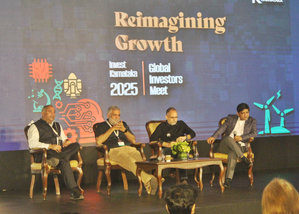Bengaluru, Feb 12 (IANS) Talking about the potential of the country in the semiconductor sector, Santosh Kumar, CEO of Texas Instruments stated that the next 10 years belong to India.
He made the statement during a panel discussion on “India’s Leadership in the Semiconductor Revolution” at the Global Investors’ Meet in Bengaluru on Wednesday.
Speaking first, Santosh Kumar stated, “The next 10 years belong to India in the semiconductor sector. During this period, the industry’s current turnover of $ 40 billion is expected to exceed $ 400 billion. However, to make the most of this opportunity, we need to prioritize high-quality educators, research, and practical learning in our education system. The government must encourage research activities in educational institutions that focus on finding efficient solutions to national challenges.”
India is working towards becoming a $5 trillion economy in the coming years, of which $3 trillion is expected to come from the ESDM (Electronics System Design and Manufacturing) sector. However, these opportunities are not exclusive to India — other nations are also competing. If India wants to take the lead, we must strengthen our quality education system, he emphasized.
He opined that quality education and research are key to India’s semiconductor growth.
Jitendra Chadda Managing Director, Global Fab Engineering Solutions pointed out that while India contributes 25 per cent to global semiconductor chip design, we lag in manufacturing. In the next 5 to 10 years, artificial intelligence (AI) will dominate every industry, leading to a surge in personalized chip design expertise, which will require investments of $15 to $20 million.
The world’s largest economies are now relying on the semiconductor industry. While Taiwan and Japan are currently at the forefront of chip manufacturing, India is yet to create a fully developed ecosystem that supports semiconductor growth, he observed.
Hitendra Garg Vice President, NXP Semiconductors shared an example, stating, “Twenty years ago, when NFC (Near Field Communication) technology was introduced, there were hardly any users for it. We had to wait nearly a decade for widespread adoption. However, today, chip designs measured in nanometers are being developed right here in Bengaluru. This highlights the power of technology.”
He further noted that Karnataka’s universities, colleges, and startups hold tremendous potential for the semiconductor sector.
India, and especially Karnataka, is already a global software hub, and Bengaluru is home to extensive electronics research and development. However, the lack of market-driven applications for these innovations is a major challenge. In addition, more collaborations and partnerships must be encouraged. Without this, industrial growth will remain stagnant, he cautioned.
The session was moderated by Rangesh, a senior executive at Lam Research.
–IANS
mka/dpb






























